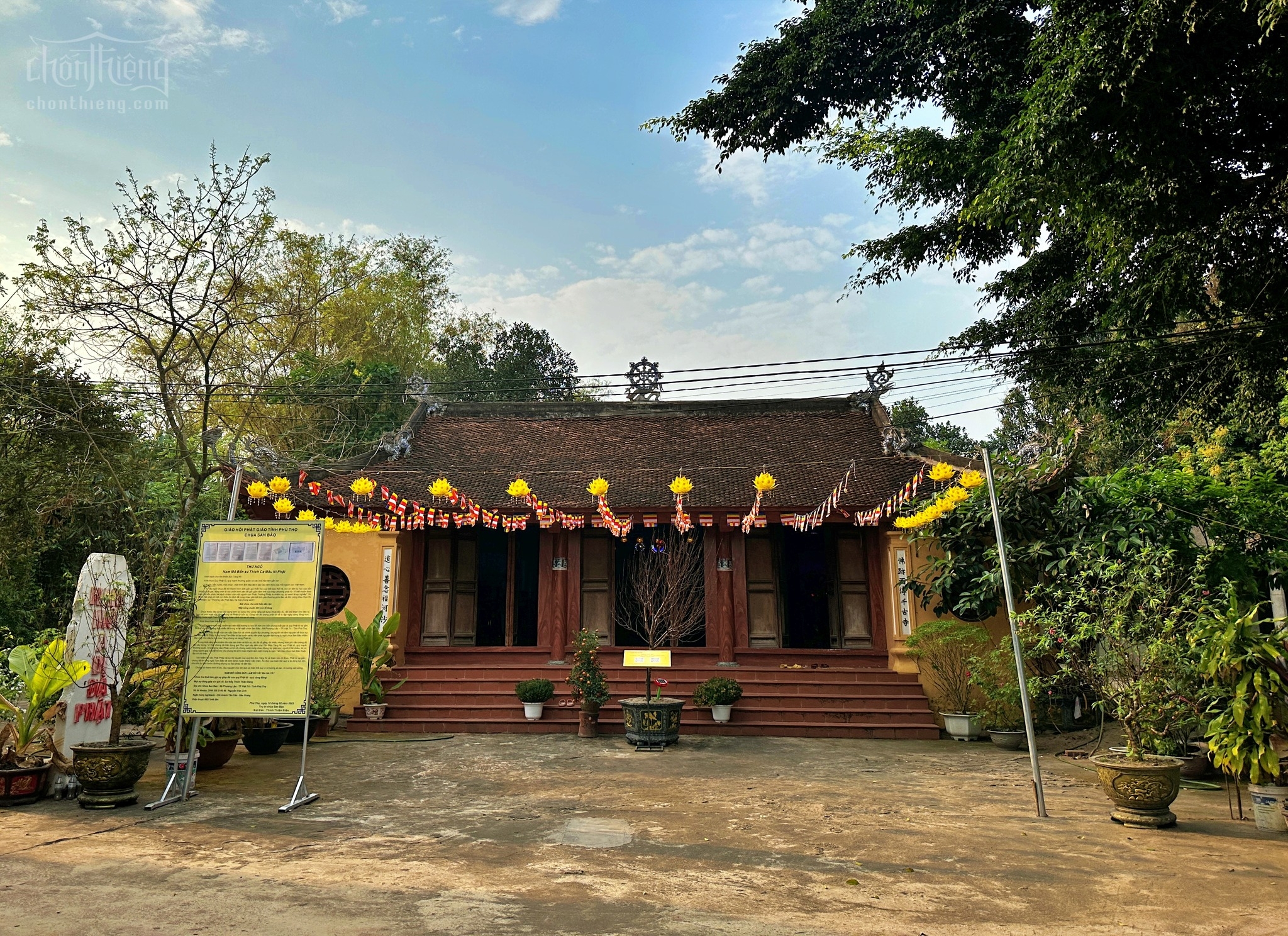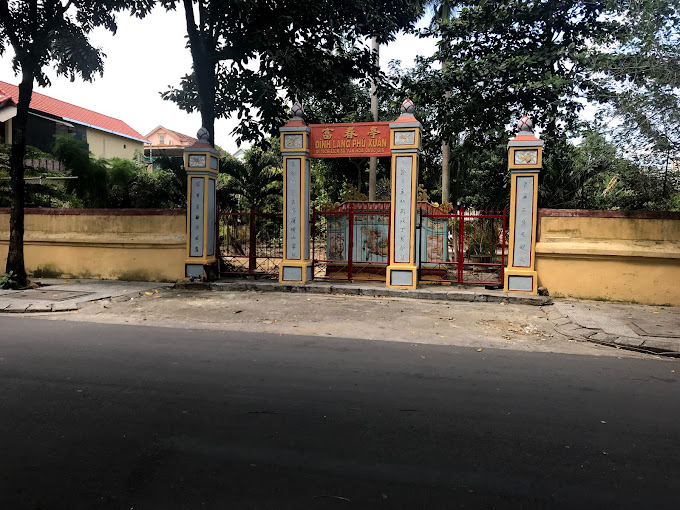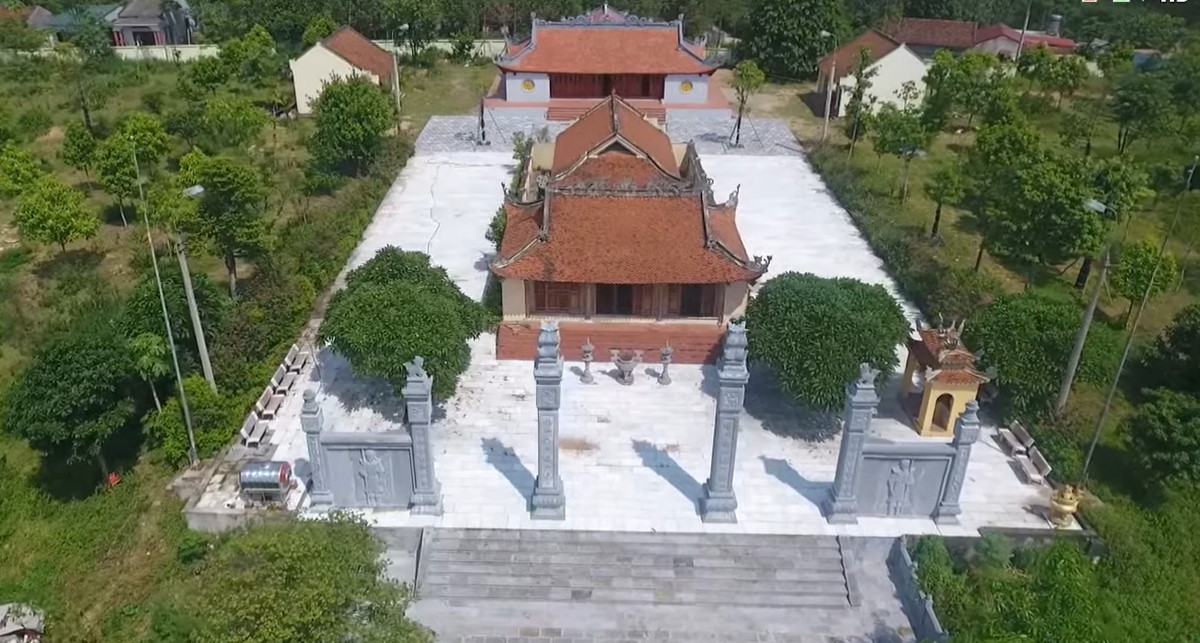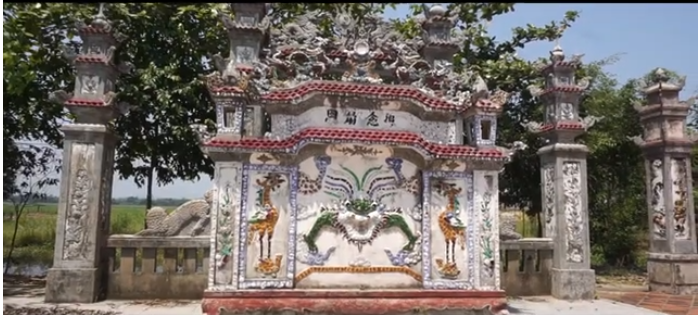Relic point Vietnam
Việt NamSan Bao Pagoda
San Bao Pagoda is called San Bao Tu (called by the bell), the name among the people is: Phuong Lau Pagoda (called by the relic site). The pagoda looking towards the East - South direction has an architectural layout in Cong style including 03 buildings: Tien Duong, Thieu Huong (waterpipe) and Thuong Dien with a total area of 167.4m2. The pagoda was built in the Later Le Dynasty - 18th century and was renovated and embellished in 2014 to meet the spiritual needs and Buddhist ceremonies for good deeds of people from all walks of life in the Commune as well as Buddhists everywhere. Every region has a good mind. San Bao Pagoda is the meeting place and establishment of the Chien Thang Commune Cell, which is where the soldiers in the commune are stationed. San Bao pagoda's ceremonies include: Daily chanting of Buddhist sutras, worshiping of Buddha on full moon days and first days of every month, requiem ceremonies for the souls of the dead, and other religious holidays such as: Thuong Thuong ceremony. Nguyen (full moon day in January), Trung Nguyen festival (full moon day in July). The ceremony to pray for peace in the lower fourth month of the lunar calendar, late spring and early summer is also a ceremony to eliminate pests from destroying crops. Buddha's birthday (April 15) is called the festival of Vietnamese Buddhism, with The ritual of changing Buddha's clothes. San Bao Pagoda is the only religious building in Phuong Lau commune that still preserves a system of ancient statues (37 statues) arranged in the prescribed order of statues. Research on science and history of San Bao Pagoda relics is a valuable relic of religious spirituality and has profound spiritual significance in every person. This is a relic that still preserves the inherent values in a land rich in cultural traditions, all expressed through the system of Buddha statues and the architecture of the Temple. In addition to the number of Buddha statues, the pagoda also preserves 3 stone steles (one side is a Buddha statue, the other is a stele) with typical values during the post-Le period. A bronze bell is 0.95 m high and 0.49 m in diameter. SOURCE: PHU THO NEWSPAPER
Phu Tho 2625 view
Du Yen Temple
Du Yen Temple is located in Chi Tien commune, Thanh Ba district. Here the trees are green and the rivers and mountains are charming. In front of the temple is the Thao River singing day and night, accumulating alluvium. Behind the land is like a saddle connected to Son Ngoc mound, surrounded by a lotus pond. According to records, in the early years AD in the Thao Giang area, Thanh Ba district, a good farmer family gave birth to a daughter and named her Hanh Nuong. This little girl was well educated, growing up to study both literature and martial arts. She is a smart girl who studies well, has great beauty, and has a gentle personality. When she grew up, many talented men in the village who approached her refused, not wanting to get dusty in order to keep themselves pure. In the year Hai Ba Trung rose uprising, she invited Hanh Nuong to meet her. Seeing that she was perfect in martial arts, Hai Ba Trung appointed her as the leader of the advance army. After defeating To Dinh's army, female general Hanh Nuong returned to her hometown to hold a banquet to welcome the army, reward the villagers, and hold a festival on a mound by the river in the shape of a white tiger drinking water. Later, people built a temple here and named it Du Yen (meaning a place to play and party), the day of the military year falls on the full moon day of the first lunar month. Since then, every January, the villagers hold a prayer festival to remember her merits and pray for good weather and good things for the family. Over time, Du Yen temple has degraded. People in the area have repeatedly restored and preserved the ancient temple and considered it a spiritual cultural activity spot of the whole region. Since 2003, the temple has been restored and renovated, including more than 12 items with an investment of more than 6 billion VND. In 1993, the temple was recognized by the State as a national historical relic site. SOURCE: PHU THO NEWSPAPER
Phu Tho 2567 view
Phu Xuan Communal House
Phu Xuan Communal House belongs to Tay Loc Ward, (now Dong Ba Ward), Hue City, Thua Thien Hue Province. Phu Xuan Communal House was built around the beginning of the 15th century, is a historical architectural relic associated with the historical place of Phu Xuan, where Lord Nguyen chose to place the royal palace of Dang Trong, the capital of Phu Xuan under the reign of King Quang Trung. and the Nguyen Dynasty. The communal house includes the Tam Quan gate, a screen, the Meeting Pavilion and the Tet Communal House. The Tam Quan Gate has 4 square pillars, the two middle pillars are 4.10m high, 0.48m wide, the two side pillars are 3.60m high, 0.5m wide. 48m. The pillar is decorated with images of lotus buds, flowers, and parallel sentences. The screen is 2.90m high, 4m wide, 0.58m thick. Behind the screen is a 1.50m high incense burner built of bricks and cement. The communal house is a three-compartment, two-winged house, 17.80m long and 10.60m wide. The communal house has 8 large columns, 12 small columns, cross-terrain paths, and trusses decorated with stylized floral motifs, all made of ironwood and kien kien. The roof is tiled. The communal house is 10.50m long, 15.90m wide, built in the style of "upper river, lower village", the roads through the land, the three links are made of ironwood, carved with stylized flowers and leaves. The roof is tiled. The middle part worships those who started farming, the left part worships those who have contributed to the village and the family, the right part worships the Ancestors. Phu Xuan Communal House is a unique folk architecture, the only one in the Imperial City, proving the formation and development of the capital Phu Xuan. Phu Xuan communal house has been ranked by the state as a national historical, architectural, and artistic relic in Decision No. 2754/Decision No. 2754/Ministry of Culture and Information dated October 15, 1994. Source: Thua Thien Hue Electronic Information Portal.
Hue 3074 view
Dinh Lai The
Lai The communal house is located in Phu Thuong commune, Phu Vang district (now Phu Thuong ward, Hue city), Thua Thien Hue province. The communal house was built in 1741, during the reign of King Le Hien Tong, the 2nd Canh Hung era. This is one of the ancient communal houses in Thua Thien Hue with historical and architectural and artistic value. Lai The Communal House consists of a three-compartment Dai Dinh building, two double wings, the middle room is 2.95m wide, the two side rooms are 2.90m wide, and the two wings are each 1.7m wide. The entire communal house has 54 columns, divided into 8 horizontal rows and 7 vertical rows, the communal house's architecture is in the style of "overlapping roofs", "stacked trusses" or "several stacks", which is typical of the architecture of the Nguyen Dynasty. The entire communal house The layout includes: The communal house, the courtyard, the communal house gate, and the row of pillars linked together along a vertical axis. The carved and decorative patterns in the communal house all have high artistic value build The building was repaired many times in 1780, 1845, 1891 and 1998. Lai The communal house still preserves many precious relics: 4 gilded lacquered lacquered panels with Chinese characters, a system of parallel sentences and 6 ordinations. The kings gifted them to openly cultivate, build and expand Lai The village. Every year, two main ceremonies usually take place at Lai The Communal House, which are: Spring Ceremony and Autumn Ceremony Offering sacrifices to the gods and ancestors to show gratitude to the villagers, these activities are still maintained and preserved by the villagers as a traditional beauty of Lai The villagers. With its architectural and artistic values, Lai The Communal House has been recognized as a national monument, according to Decision No. 04/2001 Decision - Ministry of Culture and Information dated January 19, 2001 of the Ministry of Culture. This information is from the Ministry of Culture, Sports and Tourism. Source: Thua Thien Hue Electronic Information Portal.
Hue 2687 view
Thanh Duyen Pagoda
Thanh Duyen Pagoda is an ancient site located on My Am Mountain (later changed to Thuy Hoa and then Thuy Van but locals often call it Tuy Van), Vinh Hien commune, Phu Loc district, close to the northern bank of Cau Hai lagoon, near Tu Hien estuary, built during the reign of Lord Nguyen Phuc Chu (1691 - 1725), in 1830 was upgraded by King Minh Mang, built a series of architectural works and named "Holy Duyen Tu". During the Nguyen Dynasty, this was a national pagoda, which the royal court took care of and restored and appointed famous monks to serve as monks and presiding officers. Thanh Duyen Pagoda is an ancient site located on My Am Mountain (later changed to Thuy Hoa and then Thuy Van but locals often call it Tuy Van), Vinh Hien commune, Phu Loc district, close to the northern bank of Cau Hai lagoon, near Tu Hien estuary, built during the reign of Lord Nguyen Phuc Chu (1691 - 1725), in 1830 was upgraded by King Minh Mang, built a series of architectural works and named "Holy Duyen Tu". During the Nguyen Dynasty, this was a national pagoda, which the royal court took care of and restored and sent famous monks to act as monks and preside over it. The beautiful scene of Thuy Van mountain with the Thanh Duyen Tu relic was ranked by King Thieu Tri as the ninth among the twenty beautiful scenes of Than Kinh land with the article "Van Son's beautiful relic" accompanied by a panoramic painting of the floating Thanh Duyen Pagoda. amidst the charming scenery of Thuy Van mountain, Cau Hai lagoon and the East Sea. Currently, through many restorations, Thanh Duyen Pagoda is gradually restoring the shape of the ancient pagoda with a communal house engraved with the poem "Van Son's Triumph" by King Thieu Tri built at the foot of the mountain, with a two-story pagoda gate and The main hall with 3 compartments and 2 wings also preserves bronze statues of the Three Buddhas, Avalokiteshvara, 18 Arhats, and ten Minh Vuong palaces. On the right side of the front yard of the pagoda, there is a stone stele engraved with 4 poems written by King Minh Mang about Thuy Hoa Mountain and Thanh Duyen Pagoda. In particular, in the middle of the main shrine is a bronze dragon throne with the words "The reigning Emperor Minh Mang has no reigns". Going gradually to the top of the mountain is the 2-storey Dai Tu Cac surrounded by a ceremonial gate and a citadel. On the top of the mountain is the 3-storey Dieu Ngu tower, about 15m high and Tien Sang communal house behind the tower overlooking the East Sea. Around the pagoda, there are still many ancient pine trees standing firmly over time. Source: Thua Thien Hue Electronic Information Portal.
Hue 2993 view
Giac Luong Pagoda
The location is in Hien Luong village, Phong Hien commune, Phong Dien district, Thua Thien Hue province, 21km northwest of Hue city center. Giac Luong Pagoda was built by Mrs. Hoang Thi Phieu and the patriarchs of the families in Hien Luong village during the reign of Le Trung Hung in Con Be, then moved to its current location. The pagoda is built facing south, rectangular in shape, 14.60m long, 11.48m wide, with a wooden roof, tiled roof, and includes 2 compartments and 4 wings. Next to the temple is the monk's house. The temple grounds are surrounded by rectangular walls, 79m long, 1.20m high, 0.50m thick. In front of the citadel, a pillar was built. The Tam Quan gate is massive, with an upper floor and three doors below, larger in scale than many national pagodas in Hue. In the pagoda, there are 7 Buddha statues, worshiping saints Quan Cong, Quan Binh, and Chau Xuong. The pagoda is descended from 12 ancestors of the families who publicly founded the Village. At the pagoda, there is still a large bell, cast in 1819, with the names of talented blacksmiths, mandarins and wealthy people who donated money to cast the bell and restore the pagoda. Giac Luong Pagoda contributes to the study of the history of the architectural style of Hue pagodas in the long mile of Vietnamese Buddhist architecture. Giac Luong Pagoda has been ranked as a national architectural and artistic relic according to Decision No. 776-Decision/Culture dated June 22, 1992 of the Ministry of Culture, Information and Sports (now the Ministry of Culture, Sports and Tourism). Sports and Tourism). Source: Thua Thien Hue Electronic Information Portal.
Hue 2882 view
Dao Xa communal house
Dao Xa communal house is located in Dao Xa commune, Thanh Thuy district, Phu Tho province. Dao Xa is an ancient land, with a long-standing culture about 1,800 years ago in Khuat Dong Lieu land, originally called Dau Village, Leather Village, later renamed Dao Xa village. The communal house's origin was built very early in the reign of Le Trung Hung (17th century). In 1924, the communal house caught fire and partially damaged its architecture. In 1930, the temple was restored and embellished. Therefore, the current architecture of Dao Xa communal house bears the mark of the Later Le and Nguyen dynasties. This place worships Hung Hai Cong (the 19th brother of King Hung), who was instrumental in opening up land, teaching people how to manage water, cultivate, raise livestock, and build prosperous villages. This place also worships three water gods, the three sons of Hung Hai Cong. Dao Xa Communal House is made in a triangular style with 3 buildings: Front altar, middle altar and rear palace. The temple's foundation is made in the style of gradually increasing towards the apse, the foundations are 0.40m higher than each other and are separated by an open-air courtyard. The architectural frame is made in the style of four pillars inside a boat; The set is structured in the style of stacking beams, gong stands, and lower sevens. With its cultural and historical values and sophisticated sculpture art, Dao Xa Communal House was recognized as a National Historical Site in 1974 and is one of the oldest communal houses in the province still preserved to this day. now. SOURCE: PHU THO NEWSPAPER
Phu Tho 2713 view
Memorial area of President Ho Chi Minh
The memorial area of President Ho Chi Minh is located on a flat land, shaded by green trees, in the middle of a charming midland countryside, in area 12, Van Xuan commune (formerly Co Tiet commune), Tam Nong district, province Phu Tho. The 2,780m2 memorial area includes works such as: welcome gate, memorial house, Mr. Hoang Van Nguyen's house - where Uncle Ho stayed from March 4 to March 17, 1947, on the way to the base. Viet Bac resistance war. The memorial house was started construction in 1994, and in 1995, it was recognized as a National Historical and Cultural Monument. The memorial area of President Ho Chi Minh in Van Xuan commune is a historical and cultural relic marking the image of Uncle Ho in the hearts of the people of the Ancestral Land of Phu Tho, and is a "red address" to educate patriotic traditions and hearts. national pride and sacred feelings of compatriots, comrades, and soldiers towards beloved Uncle Ho./. SOURCE: Central Agency of the Communist Party of Vietnam
Phu Tho 3052 view
Temple of King Ly Nam De
Temple of King Ly Nam De Located on spacious land with high terrain at Co Bong mound, Van Xuan commune, Tam Nong district, Phu Tho province, the relics of King Ly Nam De's temple includes many architectural items. such as: Ritual gate, temple, garden,... With a location not far from Hung Temple, this promises to be a unique spiritual tourist destination in Phu Tho. According to history, King Ly Nam De's real name was Ly Bi, and he was talented in literature and martial arts. From a young age, he proved to be an intelligent boy with unusual qualities. He was adopted by a Dharma Zen master and allowed him to study. Thanks to his excellent martial arts skills, Ly Bi was soon promoted to be the leader of a region. At one time, he was an official for the Luong Dynasty, but was very dissatisfied with the cruel colonial officials who exploited and oppressed the people, so he left the official position to recruit soldiers, and associated with many other talented heroes and chiefs to start a military campaign. rebellion against the Luong Dynasty's colonial rulers in Giao Chau. At the end of 541, Ly Bi officially started an army against the Liang dynasty. With the support of many people, Ly Bi's force grew stronger. In January 544, Ly Bi proclaimed himself Ly Nam De, ascended the throne, named the reign Thien Duc, established a hundred mandarins, named the country Van Xuan, and established the capital in O Dien (now Ha Mo commune, Dan Phuong, Hanoi), built Van Tho Palace as a meeting place. Relics worshiping Ly Nam De are currently scattered across the provinces: Thai Binh, Thai Nguyen, Hanoi, Vinh Phuc, Phu Tho... but only in Phu Tho is there a temple at the place where he died and a mausoleum of his family. king. SOURCE: People's Army Newspaper
Phu Tho 3051 view
Hoa Phong communal house
Hoa Phong communal house is located in Thuy Tan commune, Huong Thuy town, Thua Thien Hue province, 15km southeast of Hue city center, 3km from Phu Bai airport. The people of Hoa Phong have a tradition of patriotism, courage and resilience. During the two resistance wars against French colonialism and American imperialism, Hoa Phong people made many contributions to the revolution. Hoa Phong Communal House is the place to witness important historical events of the homeland during the revolutionary struggle. The village communal house is the place to organize many fundraising activities to support the resistance war such as "Bronze Week" and "Golden Week". For many years, Hoa Phong Communal House has been the workplace of Provincial Party Committee leaders such as comrade Tu Minh, comrade Ha (Len), comrades Nguyen Hung, Hoang Lanh, Hoang Dac, Le Trong Bat... Especially In March 1947, comrade Nguyen Chi Thanh - Secretary of the Binh Tri Thien Party Committee held a meeting at Hoa Phong Communal House and identified Hoa Phong as a hidden base of the revolution, a contact point, within the system. lobby supply between the plain and the war zone. The people of Hoa Phong made many contributions to the resistance war against the US to save the country and Hoa Phong Communal House is the contact address between Huong Thuy district (now Huong Thuy town) and communes in the district. Hoa Phong communal house relic has been recognized by the State as a national revolutionary historical relic according to Decision No. 1460/Quyet Dinh -Van Hoa, dated June 28, 1996. Source: Thua Thien Hue Electronic Information Portal.
Hue 3702 view











